What are Compression Hosiery and Why Wear Them?
Compression hosiery, or stockings, are primarily used to improve blood circulation and reduce swelling in legs and feet. They apply pressure to the veins and arteries, which helps improve distribution of blood and other fluids.
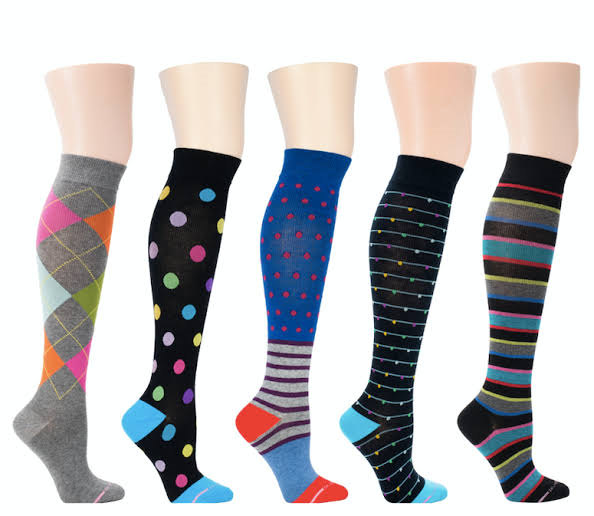
Compression socks are not limited to a particular set of people as they can be used for many reasons. Compression hose can benefit almost anyone, such as the following:
1. Helps Treat Deep Vein Thrombosis (DVT)
This occurs when blood clots form in one’s veins, which can happen in any part of the body, most commonly in the legs and thighs. Compression socks can help reduce any painful swelling caused by DVT, as well as reduce clotting by improving blood flow.
2. Helps Treat Edema and Lymphedema
This refers to swelling that is mostly caused by a buildup of fluid in various parts of the body, particularly the legs and feet. Compression hosiery can reduce swelling caused by edema and, its more severe form, lymphedema.
3. Helps Treat Varicose Veins
These are extremely visible veins that appear on the skin, especially in the legs and feet, caused when blood gathers in the veins instead of coursing back to the heart. Varicose veins can be painful, so compression hosiery are worn to reduce any pain and swelling it causes.
4. Prevents and Quickens Recovery of Exercise-Induced Injuries
Athletic people and individuals who frequently exercise wear compression hosiery, such as socks and sleeves, because it can improve their performance during training and prevent injuries. They are also useful for reducing swelling from injuries, such as sprains, and provide assistance during recovery.
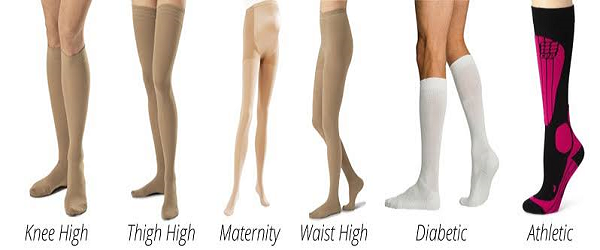
5. Reduces Swelling During Pregnancy
Pregnant women can wear compression hosiery to help reduce any swelling and discomfort in the ankles and feet.
6. Maintains Proper Circulation During Long Flights
During long flights wear mobility is restricted, the rise in altitude and being sedentary can cause legs and feet to swell or feel sore, which mild compression hosiery can be used to prevent and treat the issue.
How Long can Compression Hosiery be Worn?
The would depend on one’s health condition and severity of any health complications present.
Some health issues require compression hosiery to be worn consistently for long periods of time, such as months or years, whereas some can be worn upon choice by the user. Compression hosiery recommended by a doctor should be worn according to the doctor’s advice.
An ideal duration of time is several hours a day. They can be worn from morning but should be taken off at night before rest.

Are There any Side Effects of Wearing Compression Stockings?
Compression hosiery are highly beneficial, but there can be side effects from wearing them for too long, such as:
- Loss of circulation,
- Tingling feet,
- Joint and knee aches,
- Corns and calluses,
- Discomfort in feet, and
- Itching.
What Kinds of Compression Hosiery are There?
Compression hosiery come in a wide range of styles for men and women, with different designs, lengths, and thickness.
One of the most popular types of compression stockings is the graduated kind which applies different levels of pressure, with the strongest at your feet and the mildest at your knees, if the stockings is knee-high.
There can be variations in the following factors:
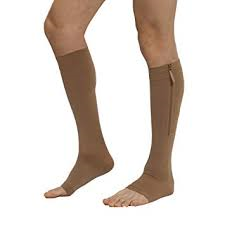
- Length: Compression hosiery come in different lengths for men and women, from ankle-length, knee-length, to waist-high. The length is selected based on where you want the pressure applied.
- Thickness: You can decide to go for a thick pair, especially when you need intense pressure. Thinner hosiery feel lighter and more breathable.
- Open-toe or closed-toe: Although the closed-toe design is widely preferred, the open-toe design can be more convenient in warmer weather as they allow one to wear sandals and slippers in the heat.
- Material: Compression hosiery can either be made with a single material or a mix. Common material used is cotton, nylon, spandex, latex, and natural rubber.
- Compression levels: Compression hosiery come in various compression levels. There are four (4) common compression levels:
- Over-the-Counter (mild compression): These come at a pressure level of 15-20 mmHg, making them quite mild. This compression level is also the most accessible, commonly available at pharmacies and does not require a prescription in order to purchase one. They are suitable for mild edema and other minor issues, and are ideal for use when working out or traveling.
- Medical Grade Class 1 (firm compression): These come at a pressure level of 20-30 mmHg. Pregnant women can use these for swollen feet, and are also suitable for sprains and other exercise-induced injuries. This level can help prevent DVT and varicose veins.
- Medical Grade Class 2 (extra firm compression): These come at a pressure level of 30-40 mmHg and provide enough pressure to relieve symptoms of severe edema, prevent DVT, and Post-thrombotic syndrome (PTS). These are suitable for post-surgery treatment and prevention of varicose veins.
- Medical Grade Class 3 (pharmacy grade compression): These come at a pressure level of 40-50 mmHg, making them the highest compression level available and, thus, require a doctor’s prescription. They are ideal for severe cases of leg swelling, varicose veins, DVT, and lymphedema.
- Over-the-Counter (mild compression): These come at a pressure level of 15-20 mmHg, making them quite mild. This compression level is also the most accessible, commonly available at pharmacies and does not require a prescription in order to purchase one. They are suitable for mild edema and other minor issues, and are ideal for use when working out or traveling.
How do I Find the Correct Compression Hosiery?
This would depend on one’s needs, severity of any health issues present, and where the compression is needed.
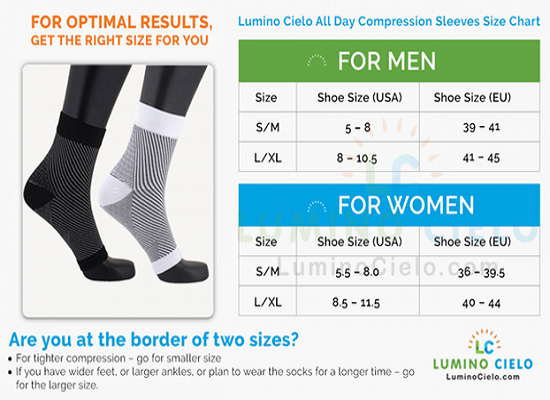
It is strongly recommended to consult with a doctor or qualified healthcare professional on the most suitable compression level and type of compression hosiery for you. Then, measuring the legs and feet will help determine what size is best.
How are Compression Hosiery Worn?
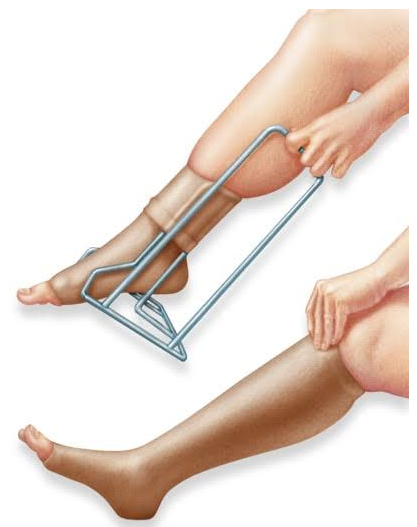
The first rule of thumb for wearing compression hosiery is to wear them on dry skin. They may not be able to slide onto the legs easily if the skin is damp.
Try the following steps when putting them on:
- Sit on a surface, such as a chair, and elevate one leg from the ground.
- Roll up one sock and begin putting it on the foot of the elevated leg, ensuring that the entire foot is covered by the sock.
- Depending on its length, gently roll the sock up to the ankle, calf or thigh.
- Smooth over the fabric to ensure there are no wrinkles and check for any folds. Repeat on the other leg.
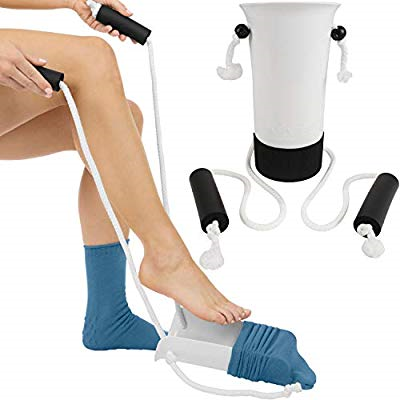
There are devices available that help make this process much faster and easier, such as a stocking donner, a sock aid, or a heel slipper for open-toe socks. These are suitable for elderly and ill people who may find it difficult to put on the compression hosiery on their own.
Tips on Wearing Compression Hosiery
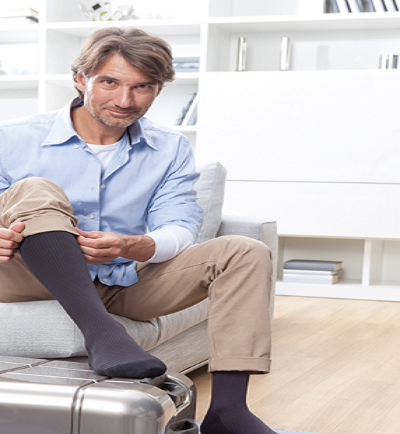
- Wearing footwear, such as shoes, socks, and slippers, while having compression hosiery on can help reduce risk of damage caused by catching onto sharp edges which could tear the fabric of the compression hosiery.
- Routinely replacing compression hosiery, such as after six months or once there is a tear in the fabric, pieces of the fabric are coming off or the hosiery has lost its elasticity.
- Purchasing two pairs of compression hosiery at a time, which would allow one to have a spare at all times.
- Wash the compression hosiery with care, such as washing by hand and with warm water.
- Routinely check for skin reactions upon wearing compression hosiery, as any redness or itching could be a sign of irritation or an allergic reaction.
Frequently Asked Questions on Compression Hosiery
Q. Why can’t I wear compression socks to sleep?
A. Wearing them at night can cause you to experience numbness around your feet and legs, so it is best to take them off before you go to bed.
Q. Should nurses wear compression socks?
A. Yes. Nurses tend to stand and move a lot throughout their work shift, so compression socks can help relieve any aches and fluid buildup in the legs.
Q. Can I wear my compression stockings while sitting down all day?
A. Yes. Compression hosiery can help tackle any swelling, aches and decreased blood circulation in the legs caused by sitting for long hours.
Q. Will I urinate more often if I wear compression socks?
A. Although there is a myth that says that wearing compression hosiery redistributes fluids back into your system, making you urinate more frequently, this is entirely false. On the contrary, people with nocturia, which is a condition where you pee a lot more frequently, especially at night, are advised to use compression hosiery to reduce the frequency of urination.
Q. How long should I wear my compression socks for flights?
A. Compression hosiery can be worn throughout the flight, if it is a short one that takes a couple hours. They should be taken off before sleeping during flights that last for more than six hours.

Q. Should I wear compression sleeves or socks?
A. Compression sleeves and socks are quite similar, only that they are worn in different areas. The major difference between the two is that compression socks cover the whole feet, while compression sleeves leave the feet open.
Conclusion
Compression hosiery, or stockings, are suitable for various health conditions, not just severe ones.
Anyone can wear them as long as they are wearing them properly and according to their needs. It is important to take the utmost care so that they can be used for prolonged periods of time.
This page last updated January 7, 2022
